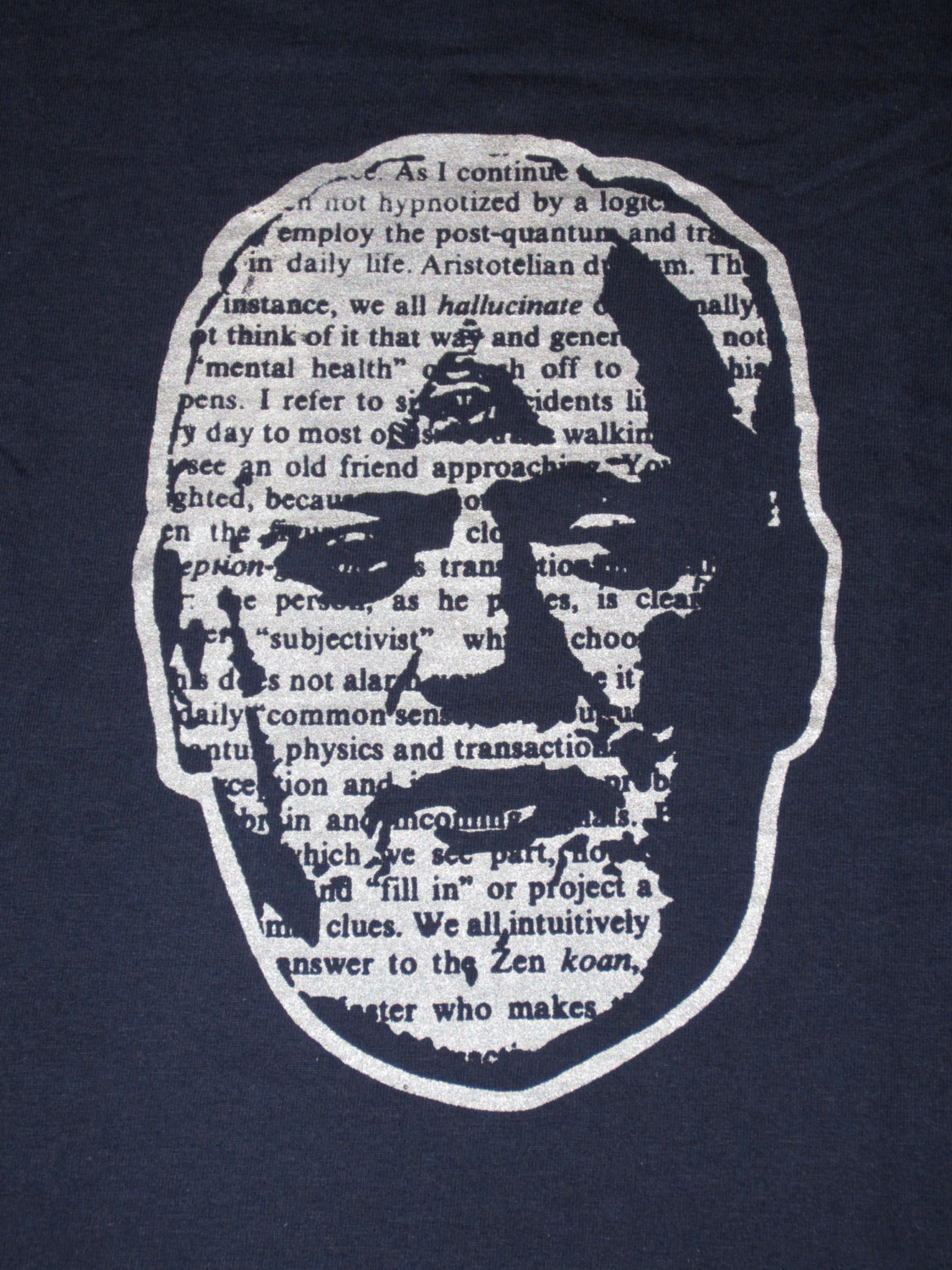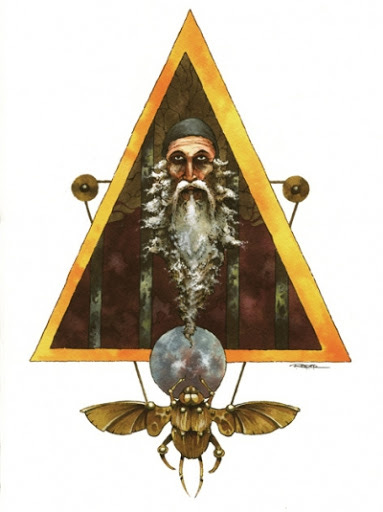
Robert Anton Wilson
Robert Anton Wilson (1932 – 2007), born Robert Edward Wilson, was an American novelist, essayist, editor, playwright, and lecturer whose playful and prolific writings helped make him one of the most stimulating and influential popular thinkers in the “head” or “freak” currents of the American counterculture in the 70s, 80s and 90s. Wilson’s large, often digressive novels, including the seminal 1975 Illuminatus! trilogy written with Robert Shea, exploited the lore of conspiracy theories and occult secret societies to explore philosophical, political, and mystical themes with a satiric and willfully “pulp” sensibility influenced by drug culture, American vernacular humor, modernist fiction, and the bawdy slapstick of underground comics. Wilson was also an original thinker whose witty, accessible, and highly discursive nonfiction texts drew from a wide range of discourses, including existentialism, phenomenology, general semantics, occultism, mysticism, sociology, anarchism, and quantum physics, not to mention his own experiments in “hedonic engineering.” Developing an expansive skepticism rooted in the phenomenology of the nervous system, Wilson argued that that “the only ‘realities’ (plural) that we actually experience and can talk meaningfully about are perceived realities – realities involving ourselves as editors – and they are all relative to the observer.” (Wilson, 1977) For Wilson, this neurological relativism demanded a “guerilla ontology” that critiqued, rejected, and culture-jammed the “reality tunnels” that dominate modern society and individual behavior. Beyond this critique, Wilson also trumpeted and embraced the creative, hedonistic, and libertarian “meta-programming” possibilities of self-reflexive reality-creation. Though his writings have not received the academic or mainstream recognition they warrant, their infectious ethos strongly influenced a number of cultural discourses that emerged from or passed through the counterculture, including occultism, libertarianism, transhumanism, psychedelia, and “New Edge” cyberculture.
Born to a working-class Brooklyn family, Wilson contracted polio as a child, and suffered the effects of post-polio syndrome off and on throughout his life. Though raised a Catholic, Wilson became a committed philosophical materialist as a teenager, dabbling in Marxism and studying engineering and mathematics at New York University. In his 20s, he underwent various courses of psychotherapy, studied existentialism, phenomenology and anarchism, and developed the “model agnosticism” he would refine throughout his life and work. In 1958, Wilson married Arlen Riley, with whom he had four children; despite Wilson’s celebration of the “Tantric” and hedonistic currents of the counterculture, they remained a devoted pair until Arlen’s death in TK. In 1962, after reading a positive article about psychedelics in the conservative National Review, Wilson embarked on an extensive exploration of peyote and eventually LSD. In 1964 he traveled as a journalist to Millbrook to meet Timothy Leary, who would become a life-long friend; Wilson’s debt to both psychedelics and Leary’s ideas was profound. In 1965, Wilson became an editor at Playboy, a job he kept until 1971. Though he later earned a degree in psychology, Wilson remained am independent author and freelance writer for the rest of his life. His blue-collar beginnings, his journalist’s commitment to entertaining (and sometimes loose) writing, and the wayward bouts of poverty he experienced raising a family as an underground intellectual helped inform the down-to-earth character of both his writing and his libertarian politics.
Wilson’s work can be conveniently divided into fiction and nonfiction, though the division is perhaps ultimately an artificial one. Wilson larded his stories with historical data and philosophical argument, and laced his essays with synchronicities and unsystematic evocations of concepts and possibilities. His quantum physics trilogy Schrödinger’s Cat represents an innovative and well-informed narrative exploration of quantum weirdness, but his most important fiction remains the Illuminatus! trilogy, co-written with Robert Shea (another Playboy editor) in the late 1960s and early 1970s but not published until 1975. Inspired by the wilder conspiracy theories mailed in by readers of the Playboy Forum, the two authors wove together a restless, baggy, satirical science fiction famously described by Greil Marcus as “the longest shaggy dog joke in literary history.” An exemplary postmodern text, though without literary pretension, Illumninatus! anticipates the conspiracy fictions later penned by Umberto Eco and Dan Brown, as well as the ongoing Masonic conspiracies associated in the 2000s with some hip-hop stars.
The novel follows various characters as they discover, combat, and propagate the feverish plots of the Illuminati, a conspiratorial global organization secretly run by a German rock band called the American Medical Association. The Illuminati lie behind the assassinations of JFK and other 1960s figures, and may or may not be responsible for a myriad of other plots and possibilities the novel teasingly and only partly unpacks. The ultimate aim of the organization is to “immanentize the eschaton,” a phrase popularized by William F. Buckley and drawn from the conservative historian Eric Voegelin, who warned against a modern utopian drive to forcibly realize the millennial kingdom on earth. Arrayed against the Illuminati are the Discordians, an underground cabal who worship and foment chaos and are headed by the submarine captain Hagbard Celine (who may or may not be the Illuminatus Primus in disguise). Robert Anton Wilson and Shea based the group on an actual Discordian Society, then one of the counterculture’s more obscure, satirical, and innovative engagements with religious mysticism, and an important influence on Robert Anton Wilson. Largely the invention of two Americans, Gregory Hill and Kerry Thornley (aka Malaclypse the Younger and Omar Khayyam Ravenhurst, who both appear in Illuminatus!), Discordianism holds that chaos is as least as fundamental to reality as order, and that it should be honored with paradox, contradiction, principled anarchism, and an irony so profane (or so silly) that it suggests the sacred. The principal Discordian text, originally published in 1965 in five copies and revised a number of times and by numerous hands, is the Principia Discordia, a parodic (and possible sincere) collage of cartoons, bad puns, Beatnik Zen, tongue-in-cheek religious language, and a deeply irreverent strain of American vernacular humor. Wilson became both an Episkopos and Pope of the Discordian Society, and was later considered “Pope Bob” by the Church of the SubGenius, which appropriated a good deal of Discordian DNA.
Placing the Discordian current within modern magical history, Margot Adler credits Kerry Thornley with first using the word “Pagan” to refer to emerging nature religions like Wicca. However, the Discordian materials themselves are not deeply marked by occult currents. In Illuminatus!, however, Wilson and Shea weave in dense historical threads about Freemasonry and ceremonial magic, make copious references to H.P. Lovecraft and other occult fiction writers, and stage scenes tinged with pop Satanism, like the obscene black mass led by Padre Pederastia in the third of the trilogy’s ten chapters, which correspond to the ten sephirot of the Tree of Life. But it was the mysterious events (or perceptions) that occurred to Wilson following the completion of the bulk of Illuminatus! in 1971 that turned him into a philosopher of the modern occult. Wilson relates these experiences in his 1977 book Cosmic Trigger: Final Secret of the Illuminati, the first volume in what would eventually become Wilson’s Cosmic Trigger trilogy of autobiographical essays. Inspired by his continuing Illuminatus! research into esoteric conspiracies and revisionist histories, Robert Anton Wilson embarked on a course of ceremonial magic and other psycho-spiritual practices that catalyzed a series of synchronicities, conceptual insights, and robust altered states of consciousness. The conspiratorial fictions he had co-written began to bleed into his personal reality, and from July 1973 until roughly October 1974, Wilson came to inhabit a “reality tunnel” in which he was receiving telepathic messages from an extraterrestrial intelligence linked the double star system Sirius.
One of the more important catalysts for this explosion of high weirdness was Robert Anton Wilson’s close reading of Aleister Crowley, whose writings Wilson had begun to explore in 1970 at the recommendation of Alan Watts (Crowley also appears as a character in Wilson’s 1981 novel Masks of the Illuminati). Drawn to the encryption and pun-filled misdirection of Crowley texts like The Book of Lies, Wilson began to decode and then experiment with ritual regimens involving drugs and sexual magic. Over time, these and other practices seemed to catalyze what Wilson called, using the language of Timothy Leary’s psycho-cybernetic model of consciousness, a new evolutionary “circuit” lying in potentia in his nervous system and DNA. Wilson came to suspect that the techniques of hedonically engineering this state was the secret that lay at the core of Illuminism and other esoteric traditions. With apotropaic doses of irony, Wilson narrates a widening paranoid web of significance that involves telepathic agents from the Dog Star, the number 23, Leary’s 1973 “Star Seed” communications, Sufism, Horus, and other florid arcana.
Cosmic Trigger can be read as an extended engagement with the uncanny conceptual and psychological powers of synchronicity, as well as an insightful spore print of California’s occult and psychedelic demimonde. But the occultist significance of this book and many of the nonfiction books that followed lies precisely in Wilson’s ability to largely come through the other side of the disturbing synchronistic web he called “Chapel Perilous.” He did so with his deployment of what Wilson calls “neurological model agnosticism.” One important inspiration for this method was Wilson’s take on the Copenhagen interpretation of quantum physics, which asserts, roughly speaking, that the manifest character of quantum objects is dependent on the instruments used to measure them. Applying this model to consciousness, Wilson held that the synchronistic or apparently supernatural effects associated with ceremonial magic do not reveal truths about reality but rather evidence for the autopoetic capacities of the human nervous system. At the same time, Wilson was not claiming simply that is all “just in the brain.” Inspired by parapsychology, Leary’s 8-circuit model, and the possible entanglement of consciousness with quantum effects, Wilson hewed to an optimistic vision of the transformative potential of the brain that significantly exceeded the boundaries of conventional naturalism. In this, Wilson can be seen as an outlier of the New Age, whose platitudes he often mocked but whose concerns—quantum physics, directed evolution, the Aquarian conspiracy—he overlapped. Indeed, Wilson’s philosophical effort may be understood as a neuro-sociological and skeptical corrective to the essential New Age gambit that we “create our own reality.”
As an occultist thinker, Wilson needs to be seen in light of his reading of Crowley, and specifically of the pragmatist and even reductionist thread that runs, inconsistently, throughout Crowley’s work. In the introduction to his 1903 edition of the Goetia, for example, the young Crowley argues that “the spirits of the Goetia are portions of the human brain.” Crowley later voiced something closer to Wilson’s own model agnosticism in “Liber O vel Manus et Sagittae,” an instruction manual for the A.:A.: that Wilson often quoted. Alerting students that they will encounter the discussion of things—like gods and spirits—which may or may not exist, Crowley asserts that “it is immaterial whether they exist or not. By doing certain things, certain results follow; students are most earnestly warned against attributing objective reality or philosophical validity to any of them.” Though offering a simplistic portrayal of the contradictory Crowley, Wilson helped propagate an influential “countercultural” vision of Crowley.
With his allergy to gurus and grand narratives, Robert Anton Wilson helped articulate and define a distinctly “postmodern” theory and method of occultism. Conceptually, Wilson affirms the rich phenomenology of occult and mystical experiences while emptying them of ontological, idealist, or supernatural claims. The negative or critical character of such doubt is balanced with the exuberant “meta-programming” possibilities rooted in the hedonic body, in experimental practice, in human intelligence, and in the virtual possibilities of the imagination and the transformative fictions it breeds. In this sense, Wilson may be productively placed in the context of a self-reflexive American reformulation of Paganism. Fellow travelers here include Discordianism, the science-fictional and originally libertarian Church of All Worlds, and the New Reformed Orthodox Order of the Golden Dawn (with whom Wilson practiced ritual); all of these groups acknowledged and celebrated their own contingent religious invention.
Robert Anton Wilson should also be considered an important progenitor of chaos magic. Like Wilson, many chaos magicians adopt a skeptical instrumentalism or “guerilla ontology,” a methodology that is sometimes coupled with a taste for social critique, absurdist humor, and the meta-fictional use of science-fiction and fantasy materials. Especially important here is the work of H.P. Lovecraft, whose Yog-Sothery saturates Illuminatus! Wilson also placed magical and mystical concerns into dialogue with a heterogenous and productive set of discourses whose influence on various counter- and subcultural fields of production remains under-appreciated. These include transhumanism, libertarianism, psychedelia, science fiction, rave culture, and the “New Edge” of early cyberculture. Wilson’s continued online influence, as well as the fellow feeling inspired by his generous disposition, was demonstrated in the months before his death in early 2007, when an Internet campaign started by Douglas Rushkoff and publicized through Slashdot and Boing Boing raised over sixty thousands of dollars for Wilson’s care in three days.
***
Adler, Margot (1986), Drawing Down the Moon: Witches, Druids, Goddess-Worshippers, and Other Pagans in America Today, Boston: Beacon.
Cusack, Carole (2010), Invented Religions: Imagination, Fiction, and Faith, London: Ashgate.
Gorightly, Adam (2003), The Prankster and the Conspiracy: The Story of Kerry Thornley and How He Met Oswald and Inspired the Counterculture, New York: Paraview.
Malaclypse the Younger and Omar Khayyam Ravenhurst, (1980), Principia Discordia: or, How I Found Goddess And What I Did to Her When I Found Her, Port Townsend, WA: Loompanics.
Wilson, Robert (1977), Cosmic Trigger I: Final Secret of the Illuminati, Phoenix, AZ: New Falcon.
Wilson, Robert (1983), Prometheus Rising, Phoenix, AZ: New Falcon.
Wilson, Robert (1991), Cosmic Trigger II: Down to Earth, Phoenix, AZ: New Falcon.
Wilson, Robert Anton and Robert Shea, (1975), Illuminatus!, New York: Dell.




